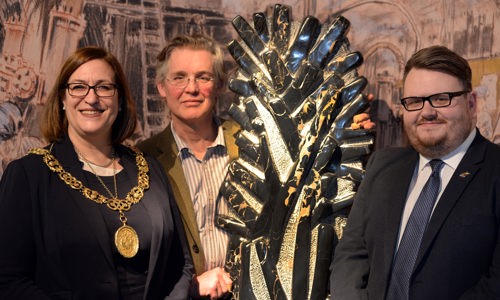
Unique sculpture depicting First World War arrives at Riverside Museum
Unique sculpture depicting First World War arrives at Riverside Museum
13 March 2018
A stunning and symbolic First World War sculpture has gone on display at the Riverside Museum, in Glasgow,
The sculpture, entitled “FRANCE 1914”, was created by artist Simon Burns-Cox who has donated it to leading Armed Forces charity Poppyscotland. Having previously been on display at the Scottish Parliament, the People’s Palace Museum and, for the past year, Kelvingrove Art Gallery and Museum, it will be exhibited at the Riverside Museum before being auctioned off with the funds going to Poppyscotland.
The Riverside Museum is located close to the former site of the famous Glasgow shipyards where many of the vessels that played a pivotal role in the First World War were built. It is a site that was at the heart of Britain’s Naval contribution to the Great War. One-hundred years ago this month saw the sinking of the HMS Calgarian with the loss of 49 lives; a vessel that had been built by the Fairfield Shipbuilding and Engineering Company Ltd on the opposite bank of the Clyde from where the Riverside Museum now sits. March 1918 also saw the Fairfield’s yard launch HMS Wolfhound, which went on to see action in both the First and Second World Wars.
While the sculpture depicts the last tree standing on the Western Front battlefield, it commemorates all who made the ultimate sacrifice in the Great War, including 43,930 members of the Royal Navy. The display will ensure their incredible contribution is not forgotten.
In attendance at the sculpture’s unveiling was Glasgow Lord Provost Eva Bolander, who said:
Glasgow Museums is proud to have displayed Simon’s thought-provoking work at the Kelvingrove Art Gallery and Museum this past year. Feedback from our visitors has reinforced our belief that it is essential we continue to share stories from the First World War to ensure such suffering is never repeated.
We are very pleased this symbolic sculpture will now be on show in the Riverside Museum. I am sure people will be struck by the beauty of the work and encourage them to spend a little time considering the devastating consequences of war, both in the past and in conflict that sadly continues today. The work will add to an already powerful collection of World War-inspired pieces, helping to inform and educate the many visitors of all ages who come to the museum.
Chair of Glasgow Life Councillor David McDonald added:
Glasgow Museums is honoured to share Simon’s poignant sculpture with our visitors at Riverside Museum. This marks the final stage of a three-year partnership with Poppyscotland that has seen the work also displayed at the People’s Palace and Kelvingrove Art Gallery and Museum. This symbolic sculpture will now remain at Riverside Museum for the coming 12 months, allowing audiences who have not yet seen this striking work to reflect on it and the conflict it commemorates.
As 2018 marks the end of the First World War, this is a fitting time to ensure the stories told by artworks such as these are never forgotten. I hope that visitors to Riverside will appreciate and enjoy the beauty of this sculpture, and that it will also encourage people to contemplate the suffering and sacrifice made by so many in the hope of securing a peaceful and better future.
At the age of 33, Burns-Cox was taken seriously ill with a brain haemorrhage which left him unable to speak for two years. During this bleak period, he discovered the art of stone carving which he found allowed him to express himself in the absence of his own voice.
When he eventually recovered after intensive speech therapy, Burns-Cox decided to train formally in stone carving in the UK and then went to Rome, where he spent nearly four years learning the skills and techniques of marble sculpture and carving from Italian craftsmen and artisans.
Edinburgh-based artist Burns-Cox said:
The sculpture was intended to represent the last remaining tree on the battlefront and a symbol of hope. It is made from black and gold Portoro marble which has been carved and highly polished by hand. It took me about a year to make.
I believe in supporting the Armed Forces in any way I can as these people have put their lives on the line for us. Perhaps, I also identify with those who have suffered having been ill myself which resulted in life-changing consequences, but also led me to becoming a sculptor.
Mark Bibbey, CEO Poppyscotland, said:
Simon’s sculpture is a striking and poignant piece of work and we were exceptionally grateful that he chose to gift it to Poppyscotland. It has been most satisfying to see it on its ‘tour’ of significant venues, and I am quite sure that the year spent at the Riverside Museum will open up this fantastic sculpture to a whole new audience.
